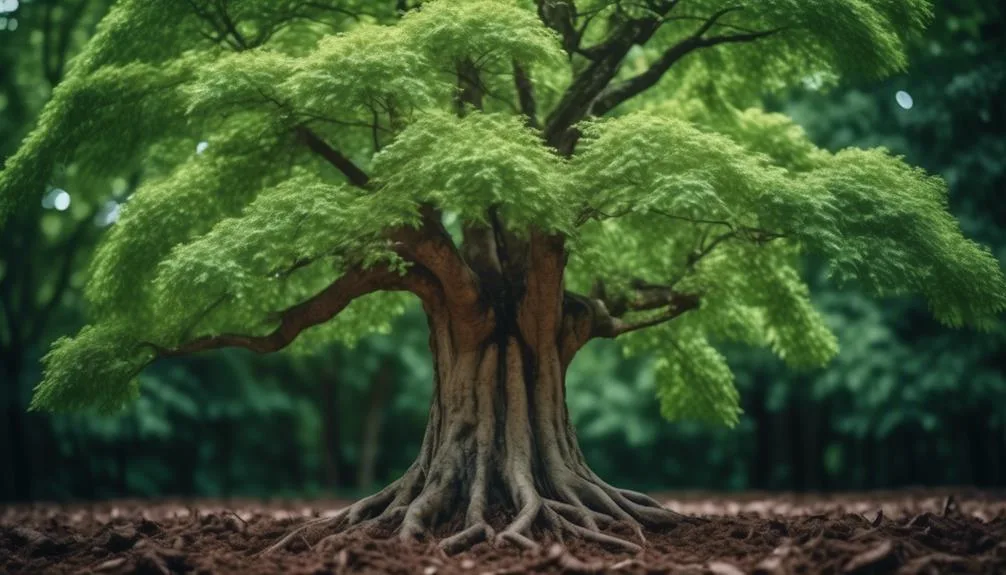Creating the perfect soil conditions for hickory trees is essential for their health and growth. Factors like pH level, soil texture, drainage, nutrients, and moisture play a vital role.
Understanding the specific requirements for hickory trees is crucial for a thriving woodland. Let's explore the relationship between soil conditions and hickory tree success, and how to optimize these factors for their flourishing.
Ph Level
To ensure the optimal growth of hickory trees, it's crucial to maintain a balanced pH level in the soil. Hickory trees thrive in slightly acidic to neutral soil, with a pH range of 6.0 to 7.0.
Understanding the natural acidity of your soil is essential before planting hickory trees. You can conduct a simple pH testing using a soil testing kit, available at most garden centers.
If the pH level is too low (acidic), you can make soil amendments by adding lime to raise the pH level.
Conversely, if the pH level is too high (alkaline), you can lower it by incorporating organic matter such as compost or well-rotted manure.
Soil Texture
For healthy hickory trees, it's essential to consider the soil texture, which directly impacts the tree's growth and development.
Soil texture refers to the composition of the soil in terms of the size of its particles. The texture of the soil greatly affects root development, water retention, and nutrient availability for hickory trees.
Sandy soils, with their larger particles, tend to drain water quickly and may not hold onto nutrients well. On the other hand, clay soils, with their smaller particles, can hold water and nutrients tightly, potentially causing drainage issues.
Loamy soils, a mix of sand, silt, and clay, offer the best soil composition for hickory trees as they provide a balanced environment, allowing for good root development, proper water drainage, and nutrient retention.
When considering soil texture, aim for a loamy composition to support healthy hickory tree growth.
Drainage
Considering the impact of soil texture on hickory tree health, it's crucial to evaluate the drainage characteristics of the soil in order to ensure optimal growing conditions. Proper drainage is essential for hickory trees as they thrive in well-drained soils.
Improving drainage can be achieved by amending the soil composition with organic matter such as compost or well-rotted manure. This enhances soil structure, allowing excess water to drain away, preventing waterlogging which can be detrimental to hickory trees.
Additionally, raised beds can be constructed in areas with poor drainage to provide a suitable environment for hickory trees to flourish. By addressing and improving drainage, you can create an ideal growing environment for hickory trees, promoting their health and overall growth.
Nutrient Content
Assess the nutrient content of the soil to ensure hickory trees receive the essential elements for robust growth and vitality.
Hickory trees require a balanced supply of nutrients to flourish. Nutrient deficiencies can hinder their development, so it's crucial to monitor the soil's organic matter, nitrogen, phosphorus, and potassium levels.
Organic matter is vital for maintaining moisture and nutrient retention in the soil, providing a steady supply of nutrients to the hickory trees.
Nitrogen is essential for leaf and shoot growth, while phosphorus supports root development and overall plant vigor.
Potassium aids in disease resistance and enhances the tree's ability to withstand environmental stress.
Regular soil testing and appropriate fertilization can help address any nutrient deficiencies, ensuring that your hickory trees have the best conditions for healthy growth.
Moisture Level
To ensure the optimal growth of hickory trees, it's essential to monitor and maintain the moisture level in the soil. Proper moisture level is critical for the health and development of hickory trees. Here are some key points to consider:
- Watering Frequency: Understanding the specific watering needs of hickory trees is crucial. Depending on factors such as the climate and soil composition, the frequency of watering may vary. It's important to strike a balance to prevent overwatering or underwatering.
- Root Depth: Hickory trees have deep roots that require adequate moisture. Ensuring that the soil remains consistently moist at the appropriate depth is vital for the overall health and stability of the trees.
- Drainage: Proper drainage is essential to prevent waterlogging, which can lead to root rot. It's important to maintain soil moisture while allowing excess water to drain effectively.
- Mulching: Mulching around hickory trees can help retain soil moisture, reduce evaporation, and regulate temperature, contributing to optimal growing conditions.
Conclusion
To ensure healthy hickory trees, prioritize the following factors:
- Slightly acidic to neutral pH
- Well-draining sandy loam
- Nutrient-rich soil
Maintain appropriate moisture levels to promote the growth of thriving trees that offer enduring beauty and shade.
Happy planting for a lush and vibrant landscape!
Mark Hoffman is a dedicated arborist and tree care specialist with over a decade of experience. His love for trees began when he visited Yosemite National Park as a teenager and was awestruck by the giant sequoias. Mark pursued his passion by studying forestry at Michigan Technological University, where he earned a Bachelor of Science degree.
Since then, he has worked tirelessly in the field of arboriculture, helping to preserve and protect trees in his community. His expertise and dedication have made him a respected leader in the industry and a valuable resource for anyone seeking advice on tree care.
